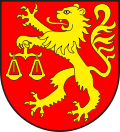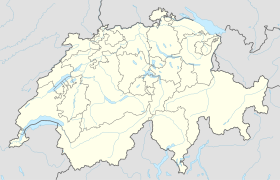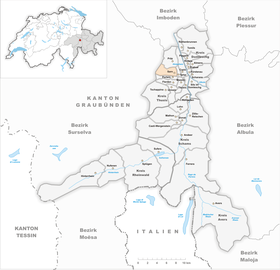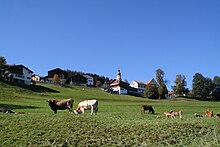Sarn
| Sarn | ||
|---|---|---|
| State : |
|
|
| Canton : |
|
|
| Region : | Viamala | |
| Political community : | Cazis | |
| Postal code : | 7423 | |
| former BFS no. : | 3666 | |
| Coordinates : | 749 947 / 175814 | |
| Height : | 1178 m above sea level M. | |
| Area : | 7.60 km² | |
| Residents: | 141 (December 31, 2009) | |
| Population density : | 19 inhabitants per km² | |
|
Sarn |
||
| map | ||
|
|
||
Sarn was a political municipality in the former district of Thusis in the Hinterrhein district of the canton of Graubünden in Switzerland.
On January 1, 2010, the municipalities of Cazis , Portein , Präz , Sarn and Tartar merged to form the new municipality of Cazis .
geography
The clustered village of Sarn is located in the middle of the Heinzenberg region and is bounded in the west by a mountain range between Tguma (2163 m above sea level) and the Präzer Höhe (2120 m). The large Alp da Sarn , an area with several alpine pastures, belongs to the municipality. Of the entire municipal area of 760 hectares, 600 hectares are therefore usable for agriculture. In addition, 115 hectares are covered by forest and wood. Of the rest, 24 hectares are settlement areas and 21 hectares are unproductive areas (mostly mountains).
coat of arms
Description: A raised golden (yellow) lion in red, holding a golden scale in his left paw.
For a long time, Sarn was the place of the rural community and the seat of court for the Heinzenberg and therefore continues the court coat of arms of the Heinzenberg, whereby the silver (white) color of the lion has been changed to gold.
population
| year | 1850 | 1900 | 1950 | 1980 | 1990 | 2000 | 2005 | 2009 |
|---|---|---|---|---|---|---|---|---|
| Residents | 259 | 150 | 168 | 129 | 148 | 159 | 141 | 141 |
languages
Originally, the residents spoke Sutselvisch , a Graubünden Romance dialect. The language change began as early as the 19th century. This took place in the interwar period. While in 1880 62% and 58% in 1910 still stated Romansh as their mother tongue, this value had fallen to 32% by 1941. A shrinking Romansh minority asserted itself until 1980. Since then the village has been monolingual. Therefore, German is the only official language today. The following table shows the development over the last few decades:
| languages | 1980 census | 1990 census | 2000 census | |||
|---|---|---|---|---|---|---|
| number | proportion of | number | proportion of | number | proportion of | |
| German | 115 | 89.15% | 144 | 97.30% | 155 | 97.48% |
| Romansh | 11 | 8.53% | 4th | 2.70% | 0 | 0.00% |
| Italian | 3 | 2.33% | 0 | 0.00% | 3 | 1.94% |
| Residents | 129 | 100% | 148 | 100% | 159 | 100% |
Origin and nationality
Of the 141 residents at the end of 2005, 138 are Swiss nationals.
Attractions
The reformed village church is a listed building .
literature
- Erwin Poeschel : The art monuments of the canton of Graubünden III. The valley communities Räzünser Boden, Domleschg, Heinzenberg, Oberhalbstein, Upper and Lower Engadine. (= Art Monuments of Switzerland. Volume 11). Edited by the Society for Swiss Art History GSK. Bern 1940. DNB 760079625 .
- The municipalities of the canton of Graubünden. Chur / Zurich 2003, ISBN 3-7253-0741-5 .
- Mathias Kundert: The language change in Domleschg and on Heinzenberg (19th / 20th century). Commission publisher Desertina, Chur 2007, ISBN 978-3-85637-340-5 .
- Jürg Simonett: Sarn. In: Historical Lexicon of Switzerland . 2016 .





